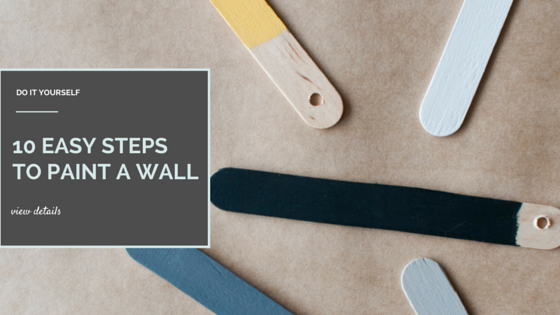Painting walls is one of the easiest and least expensive ways to change the appearance of a room. Whether the change will be positive or negative depends on how well you understand what you need to do to get professional results. Below is a simple 10-step guide that explains how to paint a wall the right way.

- Tape the trim. After preparing walls for painting, using specialized masking tape, such as Shurtape’s Frog Tape, according to label instructions to cover the trim can help paint clean, sharp lines.
- Determine the type of paint you have on your walls. Since using the wrong type of primer or paint can lead to early paint failure, figuring out the type of paint you have on your walls is very important. Rub a small area with denatured alcohol. If the paint loses glossiness or comes off on the rag, it’s latex paint; if it doesn’t, it’s oil-based paint.
- Choose the right primer. For new drywall, use a drywall primer-sealer product to level surface texture and prevent flashing. Applying a stain-blocking primer over water stains, ink or crayon will prevent bleed-through along with blistering and peeling paint. For engineered wood products, such as medium-density fiberboard, use shellac or an oil-based primer to prevent swelling. You can also find primers that allow you to switch from oil-based paint to latex paint, or vice versa, as long as the surface has been properly prepared.
- Apply the primer. Start by pouring the primer into a paint tray or five gallon bucket with a roller grid, then dip the roller into the primer, removing excess primer to prevent drips. Place the roller half way up the wall, and roll upward, close to the ceiling, and downward toward the floor, slightly overlapping each stroke. Make sure that you also prime the ceiling and all corners properly using a brush. Let the primer dry completely before painting
- Paint the ceiling. Dip the roller into the paint tray and remove excess paint. Start in one corner and proceed diagonally across the ceiling in a “W” pattern, overlapping each stroke. Make sure that you cover the ceiling line previously painted?
- Cut in corners. With a 2 to 3 inch brush, paint each corner of the wall, brushing along the corner, outward a few inches. To smooth out brushstrokes, run the brush lightly over previous strokes. Paint the rest of the wall right away to smooth out any remaining strokes.
- Paint walls along the trim. Dip a 2 to 3-inch brush into the paint and run it against the taped trim and along the ceiling line. Work it along the tape line or ceiling outward about three inches from the tape/ceiling line.
- Apply the paint. Still wondering how to paint a wall the right way? Using a 12-inch roller, roll the paint in the same “W” pattern, overlapping strokes and cut-in corners and edges. For a uniform appearance, make sure there are no missed spots. Let the paint dry properly and apply a second coat if necessary.
- Remove the tape. Allow the paint to dry for at least 30 minutes. Remove the tape, peeling it off slowly and evenly to prevent paint damage.
- Finish off the trim. After removing the tape, one more thing you need to do is to paint the trim. Start as close to the wall as possible and work your way along the trim covering from top to bottom. Use a narrow, angled brush to paint thinner areas of trim and a wide, straight-edge brush for broader areas.
For more information on how to paint a wall correctly in order to end up with a professional-looking paint job, visit our blog or contact our staff at Performance Painting.






